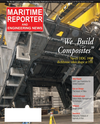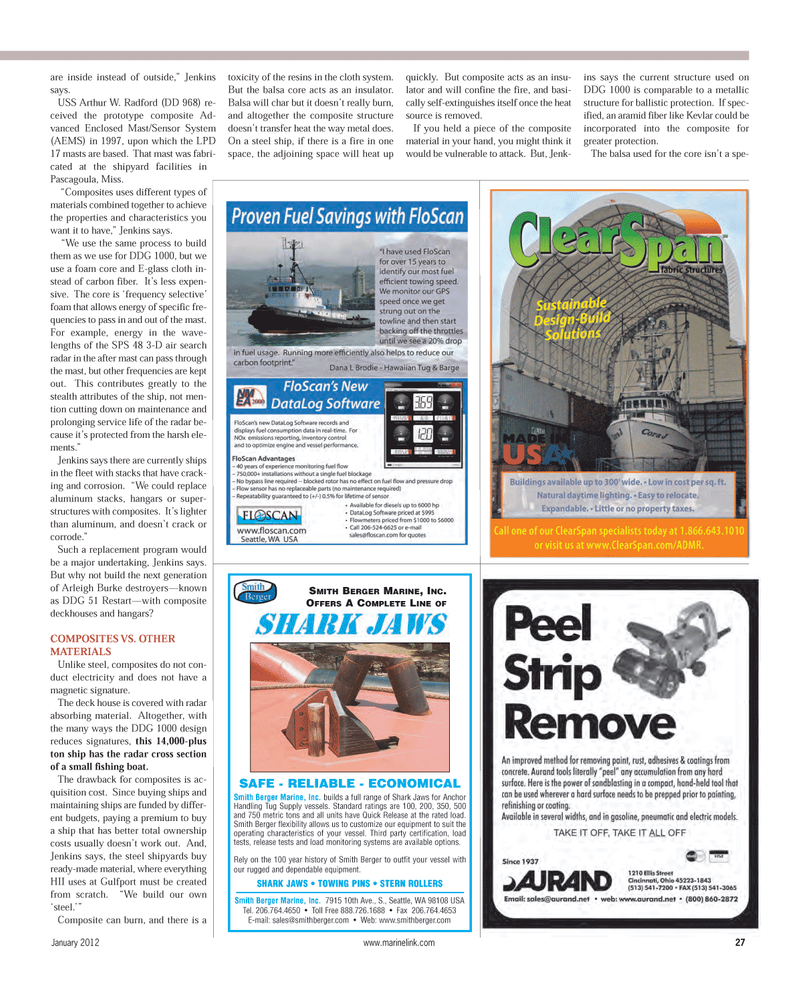
Page 27: of Maritime Reporter Magazine (January 2012)
US Navy Report
Read this page in Pdf, Flash or Html5 edition of January 2012 Maritime Reporter Magazine
are inside instead of outside,? Jenkins says. USS Arthur W. Radford (DD 968) re- ceived the prototype composite Ad- vanced Enclosed Mast/Sensor System (AEMS) in 1997, upon which the LPD17 masts are based. That mast was fabri- cated at the shipyard facilities in Pascagoula, Miss. ?Composites uses different types of materials combined together to achieve the properties and characteristics youwant it to have,? Jenkins says. ?We use the same process to build them as we use for DDG 1000, but we use a foam core and E-glass cloth in-stead of carbon fiber. It?s less expen- sive. The core is ?frequency selective? foam that allows energy of specific fre- quencies to pass in and out of the mast.For example, energy in the wave- lengths of the SPS 48 3-D air searchradar in the after mast can pass throughthe mast, but other frequencies are kept out. This contributes greatly to the stealth attributes of the ship, not men- tion cutting down on maintenance and prolonging service life of the radar be-cause it?s protected from the harsh ele- ments.? Jenkins says there are currently shipsin the fleet with stacks that have crack- ing and corrosion. ?We could replace aluminum stacks, hangars or super- structures with composites. It?s lighter than aluminum, and doesn?t crack or corrode.? Such a replacement program would be a major undertaking, Jenkins says.But why not build the next generation of Arleigh Burke destroyers?known as DDG 51 Restart?with compositedeckhouses and hangars? COMPOSITES VS. OTHER MATERIALSUnlike steel, composites do not con- duct electricity and does not have a magnetic signature.The deck house is covered with radar absorbing material. Altogether, with the many ways the DDG 1000 design reduces signatures, this 14,000-pluston ship has the radar cross section of a small fishing boat. The drawback for composites is ac- quisition cost. Since buying ships and maintaining ships are funded by differ- ent budgets, paying a premium to buy a ship that has better total ownership costs usually doesn?t work out. And, Jenkins says, the steel shipyards buy ready-made material, where everything HII uses at Gulfport must be createdfrom scratch. ?We build our own ?steel.?? Composite can burn, and there is a toxicity of the resins in the cloth system.But the balsa core acts as an insulator. Balsa will char but it doesn?t really burn, and altogether the composite structuredoesn?t transfer heat the way metal does. On a steel ship, if there is a fire in one space, the adjoining space will heat upquickly. But composite acts as an insu- lator and will confine the fire, and basi- cally self-extinguishes itself once the heat source is removed. If you held a piece of the compositematerial in your hand, you might think itwould be vulnerable to attack. But, Jenk- ins says the current structure used onDDG 1000 is comparable to a metallicstructure for ballistic protection. If spec-ified, an aramid fiber like Kevlar could be incorporated into the composite forgreater protection. The balsa used for the core isn?t a spe- Smith Berger Marine, Inc.builds a full range of Shark Jaws for AnchorHandling Tug Supply vessels. Standard ratings are 100, 200, 350, 500 and 750 metric tons and all units have Quick Release at the rated load.Smith Berger flexibility allows us to customize our equipment to suit theoperating characteristics of your vessel. Third party certification, loadtests, release tests and load monitoring systems are available options. Rely on the 100 year history of Smith Berger to outfit your vessel with our rugged and dependable equipment.SMITHBERGERMARINE, INC.OFFERSA COMPLETELINEOF SHARK JAWS ? TOWING PINS ? STERN ROLLERS Smith Berger Marine, Inc.7915 10th Ave., S., Seattle, WA 98108 USA Tel. 206.764.4650 ? Toll Free 888.726.1688 ? Fax 206.764.4653 E-mail: [email protected] ? Web: www.smithberger.com SAFE - RELIABLE - ECONOMICALJanuary 2012www.marinelink.com 27MR Jan.12 # 4 (26-33):MR Template 1/10/2012 2:19 PM Page 27

 26
26

 28
28
